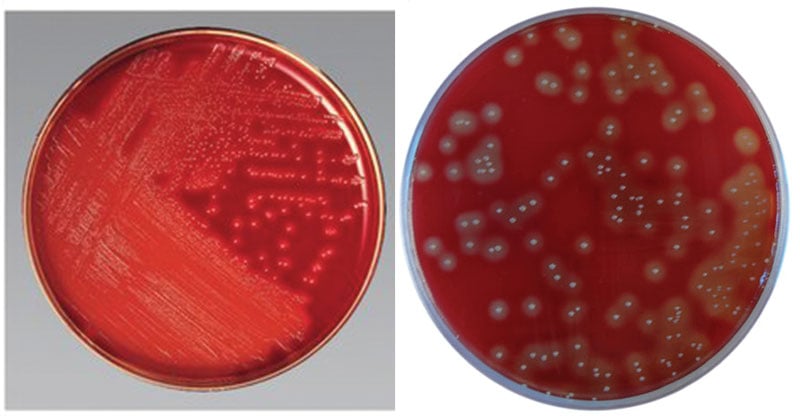Roantree et al introduced a medium for isolation of group A beta-hemolytic streptococci. The medium-enriched with yeast nucleic acid and maltose promoted increased colony size and enhanced clarity and sharpness of hemolytic zones produced by these organisms. Streptococcus Selective Agar is a selective medium recommended for use in the primary isolation of groups A Streptococcus species (S. pyogenes) from oral culture and respiratory specimens. It is designed to inhibit gram-negative bacilli and staphylococci, thereby allowing for the isolation, subculture, and identification of pathogenic streptococci, including beta-hemolytic streptococci and S. pneumoniae.
Interesting Science Videos
Composition of Streptococcus Selective Agar
| Ingredients | Grams/L |
| Casein Peptone | 15.0 g |
| Peptic Digest of Soybean Meal | 5.0 g |
| Sodium Chloride | 5.0 g |
| Nucleic Acid | 3.0 g |
| Maltose | 0.5 g |
| Neomycin | 10.0 mg |
| Polymyxin B | 10.0 mg |
| Sheep Blood | 50.0 ml (5%) |
| Agar | 15.0 g |
Final pH 7.3 +/- 0.2 at 25ºC.
Principle of Streptococcus Selective Agar
The nutritious source of organic nitrogen, particularly amino acids and long-chained peptides required by the bacterial growth are supplied by the combination of casein and soy peptones. This combination renders the medium highly nutritious. Sodium chloride maintains the osmotic equilibrium of the medium. Ribonucleic acid and maltose enhance the production of hemolysis. Supplementation with sheep blood (5%) provides additional growth factors for fastidious microorganisms and aids in determining hemolytic reactions. Selective agents such as Neomycin and Polymyxin B are added to suppress commensal oral microflora, including coliforms, staphylococci, Micrococcus, Haemophilus, and Neisseria species.
Preparation of Streptococcus Selective Agar
- Add components—except sheep blood, maltose solution, and antibiotics to distilled/deionized water and bring volume to 930.0 mL.
- Mix thoroughly.
- Gently heat and bring to boiling.
- Autoclave for 15 min at 15 psi pressure–121°C.
- Cool to 45°–50°C.
- Aseptically add sterile sheep blood, sterile maltose solution, and sterile antibiotic inhibitor.
- Mix thoroughly.
- Pour into sterile Petri dishes or distribute into sterile tubes.
Result and Interpretation on Streptococcus Selective Agar

- After 18–48 h of incubation in an atmosphere enriched with carbon dioxide, the plates show isolated colonies in streaked areas and confluent growth in areas of heavy inoculation.
- Group A streptococci ( S. pyogenes) will appear as translucent or opaque, white to gray, small (1 to 2 mm) colonies surrounded by a zone of beta hemolysis.
- Pinpoint or very small colonies of alpha-, nonhemolytic or other beta-hemolytic streptococci may grow in small numbers.
- Neisseria species, viridans streptococci, staphylococci, gram-negative rods and most beta-hemolytic streptococci other than groups A and B are inhibited on the medium.
Uses of Streptococcus Selective Agar
- Streptococcus Selective Agar is designed for the primary isolation of group A streptococci from respiratory sources.
- It can be also used in the isolation of all Streptococcus species, including streptococcal groups A (S. pyogenes), B (S. agalactiae), C, D, F, G, and S. pneumoniae, especially from respiratory specimens.
Limitations
- Some strains of group A streptococci ( S. pyogenes) may be encountered that will grow poorly on this medium; the nature of the specimens and the physiologic state of the organisms can influence the recovery of the desired species, as well as modify the effects of the inhibitory characteristics of this medium. Hence, examinations of nonselective control and compare them to the selective medium to obtain additional information and to assure optimal recovery of any potential pathogens is recommended.
- Additional biochemical tests and serological procedures are recommended for final confirmation.
- It should be recognized that organisms generally susceptible to the antimicrobial agent in a selective medium may be completely or only partially inhibited depending upon the concentration of the agent, the characteristics of the microbial strain and the number of organisms in the inoculum. Organisms that are generally resistant to the antimicrobial agent should not be inhibited. Cultures of specimens grown on selective media should, therefore, be compared with specimens cultured on nonselective media to obtain additional information and help ensure recovery of potential pathogens.
- Hemolytic reactions of some strains of group D streptococci have been shown to be affected by differences in animal blood. Such strains are beta-hemolytic on horse, human, and rabbit blood agar and alpha-hemolytic on sheep blood agar.
- The atmosphere of incubation is known to influence hemolytic reactions of beta-hemolytic streptococci. For optimal performance, incubate blood agar base media under increased CO2 (5 – 10%) in accordance with established laboratory procedures.
References
- Himedia
- Becton, Dickinson, and Company
- Hardy Diagnostic
- Thermofisher
- Neogen Corporation
- Lowbury EJ, Kidson A, Lilly HA (1964). A New Selective Blood agar medium for Streptococcus pyogenes and other hemolytic Streptococci. J Clin Pathol. 17(3):231–235.
- Bellon J, Weise B, Verschraegen G, De Meyere M. Selective streptococcal agar versus blood agar for detection of group A beta-hemolytic streptococci in patients with acute pharyngitis. J Clin Microbiol. 1991;29(9):2084–2085.
